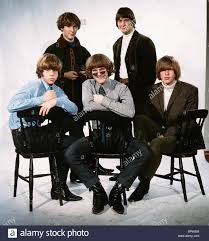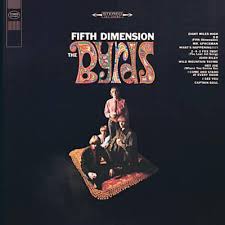Fifth Dimension
| The ByrdsFifth Dimension
Fifth Dimension is the third album by the American folk rock band the Byrds and was released in July 1966 on Columbia Records (see 1966 in music). Most of the album was recorded following the February 1966 departure of the band's principal songwriter Gene Clark. In an attempt to compensate for Clark's absence, guitarists Jim McGuinn and David Crosby stepped into the breach and increased their songwriting output. In spite of this, the loss of Clark resulted in an uneven album that included a total of four cover versions and an instrumental. However, the album is notable for being the first by the Byrds not to include any songs written by Bob Dylan, whose material had previously been a mainstay of the band's repertoire.-Wikipedia
Critic Reviews
Show All-
 All Music
All Music
Although the Byrds' Fifth Dimension was wildly uneven, its high points were as innovative as any rock music being recorded in 1966.
-
 Ultimate Classic Rock
Ultimate Classic Rock
2016. Released July 18, 1966, Fifth Dimension helped introduce fans to psychedelic rock. Critical reviews were mixed but the album demonstrated the Byrds' evolution from folk-rock to a more experimental style.
-
 Julian Cope Presents Head Heritage
Julian Cope Presents Head Heritage
On "Fifth Dimension" they are leaving that behind and becoming a full-fledged and forward-thinking "ROCK BAND" whose influence would be as great as any band of their era.
-
 Paste Magazine
Paste Magazine
2015. This album, then, cannot be considered up to the standards set by the Byrds’ first two, and basically demonstrates that they should be thinking in terms of replacing Gene Clark, instead of just trying to carry on without him.
-
 Steve Hoffman Music Forums
Steve Hoffman Music Forums
This is the Byrds' third LP and well, it's not my favorite. It's not like their first two albums at all, it doesn't stay in one genre, it shoots out to multiple genres.
-
 Wilson & Alroy's Record Reviews
Wilson & Alroy's Record Reviews
Clark quit just as the Byrds began work on their third album; it had little effect on their sound but pulled the rug out from under their gang of songwriters. The record does include the Byrds' single most memorable tune - Clark and McGuinn's breakthrough acid rock classic, "Eight Miles High," with McGuinn's brilliant Coltrane-inspired guitar solo.(JA)
-
 Free City Sounds
Free City Sounds
2013. . . . I should think that it’d be harder to argue that Fifth Dimension marks the Byrds at their most original and adventurous. The is best seen in the opening track.
-
 No Opinions Here
No Opinions Here
2017. If it’s not already clear, I adore the Byrds’ Fifth Dimension record, and believe that it’s their best album; it is complex, energetic, adolescent rock music at its apex.
-
 Progrography
Progrography
2017. Fifth Dimension is a transitional record, and not everyone likes change. Many critics, it seemed, wanted The Byrds to continue making lush, harmonic folk/rock music and serve as Bob Dylan’s personal confectioners.
-
 Don Ignacio
Don Ignacio
Soar!!!! That's what The Byrds do. After those rather boring (but unique and revolutionary) debut album and the cloned follow-up, they finally create something a little more exciting in Fifth Dimension.
-
 George Starostin's Review
George Starostin's Review
Inarguably the Byrds never ever made a bigger leap in their career than from the twin brother albums of 1965 to Fifth Dimension, and it is precisely that leap that firmly secures their high-classed position on this site.
-
 John McFerrin Music Reviews
John McFerrin Music Reviews
. . . Fifth Dimension does an excellent job of showing what I hold as one of the great truths of rock music: grafting outside influences and genres into the "simple" rock and pop form keeps the form from going stale, brings out potential positives in the form that may have gone unnoticed before, and can even create new and wonderful varieties of rock and pop music.
-
 Sundazed
Sundazed
By 1966, the Byrds had powered up like a mammoth Atlas rocket boosting Astronauts into orbit around the Earth, with their third album, Fifth Dimension. This amped-up new sound--immediately dubbed raga-rock due to the Byrds newfound fascination with the music of Ravi Shankar and John Coltrane . . . .
-
 Rezensator.de
Rezensator.de
With the third album, the Byrds dared the first experiments. One wove psychedelic structures with the classic Byrdssound, and one heard the first time significant country rock appeals (albeit very restrained).
-
 Adrian's Album Reviews
Adrian's Album Reviews
The whole record, almost without exception, actually 'sounds' great. It's a pretty damn fine album, just not what it could have been.
-
 Pablo's Reviews
Pablo's Reviews
2016. "Fifth Dimension" is, despite some imperfections, a really sensational album. A real mine of wonderful melodies and original, unconventional (at the time of publication) ideas that significantly contributed to the creation of psychedelic rock.
-
 Urban Safari Store
Urban Safari Store
Although the Byrds' Fifth Dimension was wildly uneven, its high points were as innovative as any rock music being recorded in 1966. Immaculate folk-rock was still present in their superb arrangements of the traditional songs "Wild Mountain Thyme" and "John Riley."
-
 David Vrieze Daniels
David Vrieze Daniels
The whole album (with the exception of the Gene Clark song “Eight Miles High”) is missing those incredible harmonies that make The Byrds sound so special. I think it’s safe to say this album suffers from Clark’s departure. I thinks it’s a good album, but not as good as previous work.
-
 OoCities
OoCities
Alas, much more so than the previous two albums, Fifth Dimension is something of a hits-plus-filler affair, with most of the latter residing towards the end of the album.
-
 Music Stack
Music Stack
The Byrds really started to hit their psychedelic stride on their third album. Roger McGuinn's 12-string freak-outs showed that the band was not content simply to churn out folk sing-alongs.



Rate This Album and Leave Your Comments